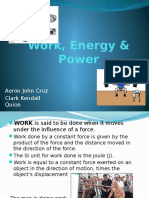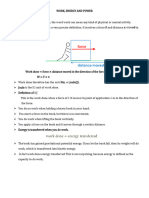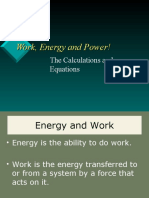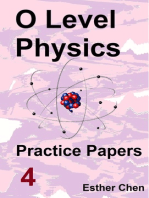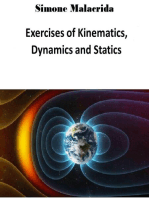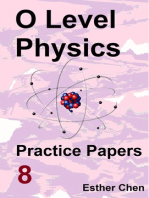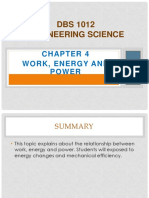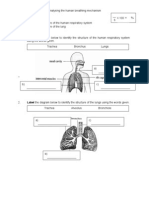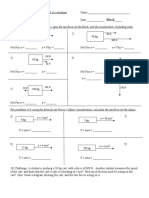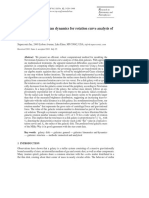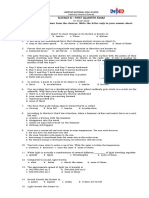Understanding Work, Energy, Power & Efficiency
Uploaded by
Eric MitchellUnderstanding Work, Energy, Power & Efficiency
Uploaded by
Eric MitchellPHYSICS form 4
Page 1 of 8
TOPIC: FORCE AND MOTION
CONTENT: a) Understanding work, energy, power and efficiency.
CHAPTER HIGHLIGHT (30 minutes)
WORK :
1. Work done = Force x Displacement in the direction of this force
W = F x s where, W = work
F = force
S = Displacement in the direction of the force
2. The SI unit for work is the joule (J).
3. Activities :
Activity 1.
Fill in the blank .
a. Work done is a form of _____________________
b. Work done is defined as a product of force and _____________________
c. Greater work done is needed if the ______________ of the object is greater and the
displacement of the object moved is longer.
Activity 2 :
A boy pushing his bicycle with a force
of 25N through a distance of 3m.
The work done by the boy ?
Solution :
Activity 3:
A girl lifting up a 3kg flower pot steadily
to a height of 0.4m.
The work done by the girl.?
Solution :
PHYSICS form 4
Page 2 of 8
Activity 4 :
A storekeeper pulling a box along the
floor with a force of 40N through a
distance of 6m.
The work done in pulling the box.?
Solution :
ENERGY
1. Energy can be defined as the capacity to do work.
2. Energy transfer when work is done.
3. Form of energy :
4. Kinetic Energy ( Ek ) ,
Ek = mv
2
Activity :
What is the kinetic energy of a man of mass 50kg jogging at a velocity
of 3m/s ?
Solution :
Kinetic energy is the
energy of an object due
to its motion
Gravitational potential
energy is the energy of an
object due to its higher
position
Elastic potential energy is
the energy stored is a
stretched object
Sound energy is released
by vibrating tuning fork
Heat energy is the energy
released by a hot object
when it cools down
Chemical energy stored in the cell
is released as electrical energy when
a current flows in the circuit. Part of
the electrical energy is released as
light energy in the light bulb.
Forms of energy
PHYSICS form 4
Page 3 of 8
5. Gravitational Potential Energy ( Ep ),
Ep = mgh
Activity :
In a diving competition, a boy of 40kg stands on a 3m high pringboard.
What is the gravitational potentialenergy of the boy ?
Solution :
6.
(a) State the change of energy for the dolphins in the(b) State the principle of conservation
figure below of energy for the roller
. coaster in figure below.
Answer: Answer:
POWER
1. Power is defined as the rate at which work is done,
Power = Work done
Time taken
P = W
t
2. The SI unit of power is watt ( W ).
3. A power of 1W is generated when 1J of work is done in 1s.
4. Activity :
A crane with an output power of 12kW is used to lift a steel bar of mass 400kg to
a height
of 20m. What is the time taken by the crane to do this work ? (assume g =
10m/s
2
).
Solution :
PHYSICS form 4
Page 4 of 8
EFFICIENCY
1. The efficiency define as the percentage of energy which is transformed to a
useful form by a divice.
2. Efficiency (%) = Useful energy output x 100%
Energy input
3. Activity :
a. The rate of energy transfer is equivalent to ____________________
b. Another unit for J s
-1
is ______________
c. A man pull a rickshaw with a total force of 2800N. After he has pulled for 25m,
the 100kg rickshaw is moving at a speed of 6m/s.
Calculate the efficiency with which the man is using his energy to pull the
rickshaw.
Solution :
Energy input = work = Fs
W = Fs
= 2800 x 25
= 70 000J = 70kJ
Energy output = kinetic energy of the rickshaw
= mv
2
= 1/2 x 100 x 6
2
= 1800J = 1.8 kJ
Efficiency (%) = ?
ASSESSMENT :( 40 minutes)
PHYSICS form 4
Page 5 of 8
Section A
1 A stone of mass 8 kg is lifted to a vertical height of 3 m. What is the work done to the
stone?
[g = 10 m s
-2
]
A 24 J B 80 J C 240 J D 2400J
2. A girl a mass of 50 kg take s 4 s to run up a stair with a height of 5 m. How much
potential energy does she gain.
A 1.0 kJ B 1.5 kJ C 2.0 kJ D 2.5 kJ
3. A lorry of mass 5 000 kg moves with a constant velocity of 4 m s
-1
along a horizontal
road. What is the kinetic energy of the lorry in kJ?
A 20 kJ B 25 kJ C 40 kJ D 100 kJ
4. A load of mass 4 kg is lifted from a height of 5 m through a height of another 10 m.
What is the increase in gravitational potential energy of the load? [g = 10 m s
-2
]
A 400 J B 200 J C 100 J D 50 J
5. Which of the following device has the best efficiency ?
A Diesel engine
B Electric engine
C Steam engine
D Petrol engine
Section B
1 A ball of mass 120 kg is situated at a height of 3.6 m from the
surface of the floor as shown in the figure. When the ball rolls
down a smooth rail, what is the speed of the ball just before it
reaches the floor?
[g = 10 m s
-2
.]
Floor
3.6 m
PHYSICS form 4
Page 6 of 8
2 A ball of mass 0.2 kg is thrown vertically upwards from the surface of the Earth with
an initial velocity 20 m s
-1
. What is the maximum gravitational potential energy
acquired?
3 The figure on the right shows a conveyor belt system carrying a
load of mass 30 kg from position X to position Y in 15 seconds.
What is the output power of the conveyor system?
Section C
1. A student with a mass of 40 kg carries a bag of mass 5 kg and is going up a
staircase. The staircase has 10 steps and each step of staircase has a height of
0.2m.
a) According to the information above,
i) what is work and its S.I unit?
ii) how much work has the student done to reach the top of the staircase ?
b) i) What is power and its S.I unit?
ii) How much powe has the student spent if he take 10s to reach the top?
Conveyor belt
Load
X
8m
6 m
Y
PHYSICS form 4
Page 7 of 8
Marking scheme.
Work
Activity 1
a. energy
b. work
c. force
Activity 2
W= F x s = 25 x 3 = 75J
Activity 3
W= F x s = mgh = 3x 10 x 0.4= 12 J
Activity 4
W= F .s = 40 x 6= 240J
Section A
1. C 2. D 3. C 4. B 5. B
Section B
1. v
2
= 2gh
= 2 x 10 x 3.6
= 72
v = 8.5
2. v
2
=u
2
+ 2as
v
2
= 20
2
+ 2 (10) s
s = 20 m
s = h = 20 m
Ep = mgh = 0.2 x 10 x 20 = 40 J
3. Output,P= mgh = 30 x 10 x14
15
= 280 W
Section C
1. (a) (i) Work is the product of an applied force (F) and displacement (s) of an
object in the direction of the applied force.
(ii) W = Fs
= (m1g + m2g)s
= 1100 J
= 1.1 kJ
PHYSICS form 4
Page 8 of 8
(b) (i) Power is the rate at which work is done
Power,P= Work/time
(ii) P = 1100/ 10s = 110 W
You might also like
- BB101 Engineering Science Chapter 4 Work Energy Power50% (2)BB101 Engineering Science Chapter 4 Work Energy Power10 pages
- Science Form 3 2020 (Notes, PBD, Exercise) : Chapter: 7 Energy and PowerNo ratings yetScience Form 3 2020 (Notes, PBD, Exercise) : Chapter: 7 Energy and Power21 pages
- Report For Experiment #7 Work and Energy On The Air Track: Lab Partner: Yifan Guo TA: Benjamin AkersNo ratings yetReport For Experiment #7 Work and Energy On The Air Track: Lab Partner: Yifan Guo TA: Benjamin Akers32 pages
- Chapter 4 Work Energy and Power (Lecturer Only)No ratings yetChapter 4 Work Energy and Power (Lecturer Only)52 pages
- Jss 2 Basic Science Second Term PPT - 2No ratings yetJss 2 Basic Science Second Term PPT - 275 pages
- Chapter 1 - Energy, Power and Efficiency (Answers)No ratings yetChapter 1 - Energy, Power and Efficiency (Answers)7 pages
- 2.10 Understading Work, Energy, Power and Efficiency: Learning OutcomeNo ratings yet2.10 Understading Work, Energy, Power and Efficiency: Learning Outcome24 pages
- Work, Energy & Power: Aeron John Cruz Clark Kendall QuionNo ratings yetWork, Energy & Power: Aeron John Cruz Clark Kendall Quion19 pages
- 2.10: Work, Energy, Power and EfficiencyNo ratings yet2.10: Work, Energy, Power and Efficiency24 pages
- Electricity and Magnetism Physical Science Presentation in Colourful Bright Textured Illustration StyleNo ratings yetElectricity and Magnetism Physical Science Presentation in Colourful Bright Textured Illustration Style32 pages
- Work. Energy and Power - Theory - As - PDF FormNo ratings yetWork. Energy and Power - Theory - As - PDF Form8 pages
- Chapiter 5 Work and Energy (Dr Megdoud Yousra )No ratings yetChapiter 5 Work and Energy (Dr Megdoud Yousra )31 pages
- IGCSE Physics Worksheet 16 Work and PowerNo ratings yetIGCSE Physics Worksheet 16 Work and Power4 pages
- LESSON 2.10 Understanding Work, Energy, Power and EfficiencyNo ratings yetLESSON 2.10 Understanding Work, Energy, Power and Efficiency12 pages
- Grade IX (Science) Chapter - Work and Energy (Notes) (2).DocxNo ratings yetGrade IX (Science) Chapter - Work and Energy (Notes) (2).Docx16 pages
- SLIDE 1 - Sci 08 (Work, Power, and Energy)No ratings yetSLIDE 1 - Sci 08 (Work, Power, and Energy)62 pages
- Science Form 2: The World Through Our SensesNo ratings yetScience Form 2: The World Through Our Senses13 pages
- Theme: Introducing Science: Learning Area: 1.0 Introduction To ScienceNo ratings yetTheme: Introducing Science: Learning Area: 1.0 Introduction To Science11 pages
- Topic: Light: Chapter Highlight: 5.4 Lenses Image Form by Convex Lenses Object Distance Ray Diagram Image Distance Image Characte Ristics Uses100% (1)Topic: Light: Chapter Highlight: 5.4 Lenses Image Form by Convex Lenses Object Distance Ray Diagram Image Distance Image Characte Ristics Uses14 pages
- Student Performance Q&A: 2001 AP Physics Free-Response QuestionsNo ratings yetStudent Performance Q&A: 2001 AP Physics Free-Response Questions8 pages
- Net Force and Acceleration Practice Worksheet100% (2)Net Force and Acceleration Practice Worksheet2 pages
- Modeling of The Rotation Curve of GalaxiesNo ratings yetModeling of The Rotation Curve of Galaxies20 pages
- sHIMADZU - Specification Sheet - LCMS-8045No ratings yetsHIMADZU - Specification Sheet - LCMS-80452 pages
- Force Propulsion System Rocket: + Text Only Site + Non-Flash Version + Contact GlennNo ratings yetForce Propulsion System Rocket: + Text Only Site + Non-Flash Version + Contact Glenn3 pages
- Physics Notes Fbise FSC 2 CHAPTER - 14 MAGNETISM AND ELECTRONo ratings yetPhysics Notes Fbise FSC 2 CHAPTER - 14 MAGNETISM AND ELECTRO6 pages
- Ruth v. Buckley (Auth.) - Electromagnetic Fields - Theory, Worked Examples and Problems-Macmillan Education UK (1981)No ratings yetRuth v. Buckley (Auth.) - Electromagnetic Fields - Theory, Worked Examples and Problems-Macmillan Education UK (1981)169 pages





















